Trends and Patterns of Disparities in Cancer Mortality Among US Counties, 1980-2014
- PMID: 28118455
- PMCID: PMC5617139
- DOI: 10.1001/jama.2016.20324
Trends and Patterns of Disparities in Cancer Mortality Among US Counties, 1980-2014
Abstract
Introduction: Cancer is a leading cause of morbidity and mortality in the United States and results in a high economic burden.
Objective: To estimate age-standardized mortality rates by US county from 29 cancers.
Design and setting: Deidentified death records from the National Center for Health Statistics (NCHS) and population counts from the Census Bureau, the NCHS, and the Human Mortality Database from 1980 to 2014 were used. Validated small area estimation models were used to estimate county-level mortality rates from 29 cancers: lip and oral cavity; nasopharynx; other pharynx; esophageal; stomach; colon and rectum; liver; gallbladder and biliary; pancreatic; larynx; tracheal, bronchus, and lung; malignant skin melanoma; nonmelanoma skin cancer; breast; cervical; uterine; ovarian; prostate; testicular; kidney; bladder; brain and nervous system; thyroid; mesothelioma; Hodgkin lymphoma; non-Hodgkin lymphoma; multiple myeloma; leukemia; and all other cancers combined.
Exposure: County of residence.
Main outcomes and measures: Age-standardized cancer mortality rates by county, year, sex, and cancer type.
Results: A total of 19 511 910 cancer deaths were recorded in the United States between 1980 and 2014, including 5 656 423 due to tracheal, bronchus, and lung cancer; 2 484 476 due to colon and rectum cancer; 1 573 593 due to breast cancer; 1 077 030 due to prostate cancer; 1 157 878 due to pancreatic cancer; 209 314 due to uterine cancer; 421 628 due to kidney cancer; 487 518 due to liver cancer; 13 927 due to testicular cancer; and 829 396 due to non-Hodgkin lymphoma. Cancer mortality decreased by 20.1% (95% uncertainty interval [UI], 18.2%-21.4%) between 1980 and 2014, from 240.2 (95% UI, 235.8-244.1) to 192.0 (95% UI, 188.6-197.7) deaths per 100 000 population. There were large differences in the mortality rate among counties throughout the period: in 1980, cancer mortality ranged from 130.6 (95% UI, 114.7-146.0) per 100 000 population in Summit County, Colorado, to 386.9 (95% UI, 330.5-450.7) in North Slope Borough, Alaska, and in 2014 from 70.7 (95% UI, 63.2-79.0) in Summit County, Colorado, to 503.1 (95% UI, 464.9-545.4) in Union County, Florida. For many cancers, there were distinct clusters of counties with especially high mortality. The location of these clusters varied by type of cancer and were spread in different regions of the United States. Clusters of breast cancer were present in the southern belt and along the Mississippi River, while liver cancer was high along the Texas-Mexico border, and clusters of kidney cancer were observed in North and South Dakota and counties in West Virginia, Ohio, Indiana, Louisiana, Oklahoma, Texas, Alaska, and Illinois.
Conclusions and relevance: Cancer mortality declined overall in the United States between 1980 and 2014. Over this same period, there were important changes in trends, patterns, and differences in cancer mortality among US counties. These patterns may inform further research into improving prevention and treatment.
Conflict of interest statement
Figures
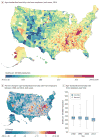
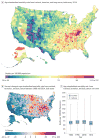
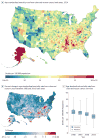

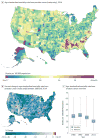
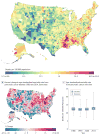
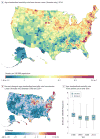
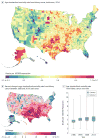
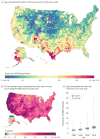
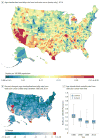
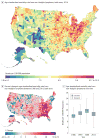
Comment in
-
Translating Cancer Surveillance Data Into Effective Public Health Interventions.JAMA. 2017 Jan 24;317(4):365-367. doi: 10.1001/jama.2016.20326. JAMA. 2017. PMID: 28118434 No abstract available.
-
Outlier in Analysis of Cancer Mortality by US County.JAMA. 2017 May 9;317(18):1910-1911. doi: 10.1001/jama.2017.4128. JAMA. 2017. PMID: 28492892 No abstract available.
References
-
- GBD 2015 Mortality and Causes of Death Collaborators. Global, regional, and national life expectancy, all-cause mortality, and cause-specific mortality for 249 causes of death, 1980–2015: a systematic analysis for the Global Burden of Disease Study 2015. Lancet. 2016;388(10053):1459–1544. - PMC - PubMed
-
- US Cancer Statistics Working Group. United States Cancer Statistics: 1999–2013 Incidence and Mortality Web-Based Report. Atlanta, GA: Department of Health and Human Services, Centers for Disease Control and Prevention, and National Cancer Institute; 2015. [Accessed May 13, 2016]. https://nccd.cdc.gov/uscs/
Publication types
MeSH terms
Grants and funding
LinkOut - more resources
Full Text Sources
Other Literature Sources
Medical

